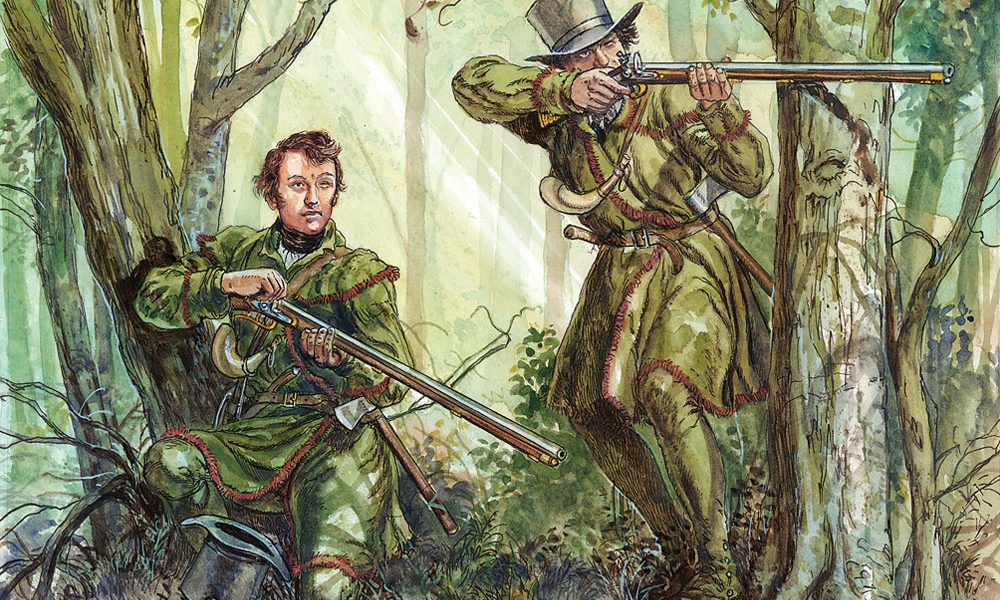History & Politics
The Men Who Saved Baltimore
The beginning of the end for the redcoats was two teenagers with muskets.
Baltimore has had many nicknames over the years, including Monument City, but one of those monuments is unfamiliar to most natives: It stands at East Monument and Aisquith streets, honoring two teenage apprentice saddle-makers, Daniel Wells and Henry McComas, who are among those legend credits with saving Charm City from being sacked and burned by the British. (To the Brits, Baltimore and its shipyards were a hornet’s nest of privateers who were pillaging British shipping.)
Frustrated when Fort McHenry refused to surrender after being pummeled by cannon and rockets from his majesty’s fleet, other British ships tried a Hail Mary play, landing a large force at North Point near the mouth of the Back River and marching up North Point Road—which runs up a four-mile-long, narrow peninsula—to come in through the back door in East Baltimore.
Word had spread to neighboring counties and states of the attack, and thousands of Americans put down their plows and carried their muskets to Baltimore to build a line of defense in what is now Patterson Park, at the center of which is a hill that offers an impressive vantage point. But as was the case at the Battle of Bladensburg, where American militiamen broke ranks and ran in the face of concentrated enemy fire, they were a motley crew, lacking military training, and most were no match for a highly disciplined British army fresh from years of war in Europe.
The first responders dispatched to counter the amphibious landing were 5,000 American militiamen, led by Brigadier General John Stricker, who planned a stalling action on North Point Road. Would the American citizens-soldiers stand and fight the crack redcoats or retreat in disarray a la Bladensburg? The British expected the latter, but suffered a crushing blow from a single musket ball.
Wells and McComas were serving with Captain Edward Aisquith’s militia rifle company, which was among the units trying to slow the British advance up the road.
In command of the British land forces was General Robert Ross, a veteran of the Napoleonic Wars with a military background spanning 25 years. Gen. Ross, noticing that Capt. Aisquith’s company had positioned itself on the North Point peninsula, decided to wait at the local farm of Robert Gorsuch, having breakfast cooked for him while waiting for the rest of his army, which totaled 4,700 soldiers and marines.
Learning of this from civilians who fled the farm, American Brig. Gen. Stricker ordered a group of 230 men, including Wells, 18, and McComas, 19, to flush Gen. Ross out of the Gorsuch farm.
The 200-year-old tale goes like this (sorry, there was no ballistics testing then): Riding on a white horse, Gen. Ross was shot and mortally wounded, with credit going to both Wells and McComas. British troops saw where the shots came from, rushed their position, and killed them both, as well as a third soldier, 24-year-old Aquilla Randall.
A more junior officer, Colonel Arthur Brooke, took over Gen. Ross’s command, but, when he went north to Patterson Park, he balked at the sight of 15,000 dug-in defenders with hundreds of cannons, stretching a mile north of Canton. After trying to outflank the defenders, but being thwarted by Brig. Gen. Stricker’s men, and knowing fresh American volunteers were pouring into the city every day from surrounding states, he beat it back to the ships at the bottom of North Point Road, and the British fleet sailed away empty-handed—and short one general.

There’s nothing like the smell of cordite in the afternoon to clear your sinuses, and the best place to take in some gunpowder-smoke therapy is the Battle of North Point re-enactment being put on by history-loving volunteers at Fort Howard at the bottom of the North Point peninsula in Baltimore County (near where British land forces came ashore in September 1814). Using about 90 re-enactors in period uniforms, the event—held Saturday, September 6, and Sunday, September 7, with additional historical events and fireworks at Sparrows Point High School (just up North Point Road) on Monday, September 8 —includes a flag ceremony, a fife and drum corps, music, craft displays, and activities for children. The three-day schedule, sponsored by the Dundalk-Patapsco Neck Historical Society Museum in partnership with the Baltimore County Department of Tourism and Star-Spangled 200, includes two battle re-enactments each on Saturday and Sunday.
For details and directions, go to the Dundalk-Patapsco Neck Historical Society & Museum website at dundalkhistory.org or call 410-284-2331.

